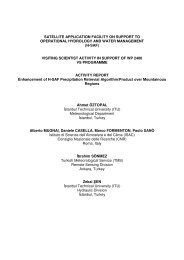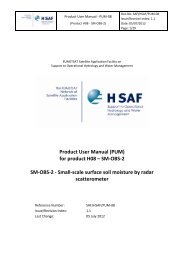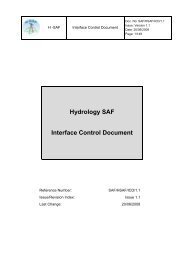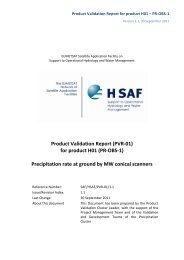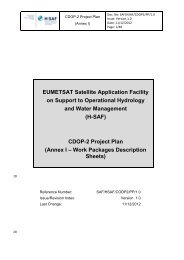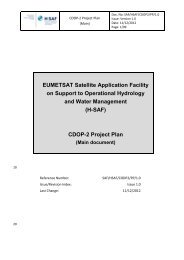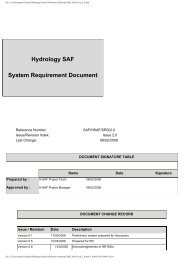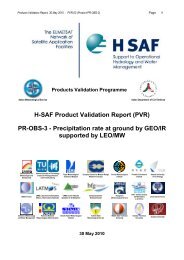(H-SAF) PROJECT PLAN - Version 2
(H-SAF) PROJECT PLAN - Version 2
(H-SAF) PROJECT PLAN - Version 2
Create successful ePaper yourself
Turn your PDF publications into a flip-book with our unique Google optimized e-Paper software.
H-<strong>SAF</strong> Project Plan 2.0, October 2007 - Update PP-2.2, 10 April 2008 - Chapter 3 (The coordination task) Page 40<br />
• the invoices are collected by the Host Institute from the H-<strong>SAF</strong> Operating Unit employing the<br />
Visiting Scientist;<br />
• the collected invoices are delivered to Austria after:<br />
- endorsement by the responsible Cluster leader;<br />
- endorsement by the Project Scientist.<br />
WP-1140: Planning and Editing<br />
This is a supporting task for the implementation and updating of basic programmatic/scientific<br />
documents such as (see Tables 8 or 9) (each document to imply several issues for different Reviews):<br />
• the Project Plan (PP);<br />
• the User requirements Document (URD)<br />
• the Algorithm Theoretical Definition Document (ATDD)<br />
• the series of Reports (REP) on specific items, and Workshop proceedings<br />
• the User Manual (UM) and the Final Report (FR).<br />
These documents, especially the URD, come upstream of the engineering documentation, produced<br />
under WP-1330. The Planning Officer, on the base of the Development Proposal [Ref. 2] and previous<br />
discussions and negotiations [Ref. 1], submits draft documents or document frames to the H-<strong>SAF</strong><br />
Participants, collects the contributions and performs editing of the documents to be delivered to the<br />
Review meetings. For those documents, he coordinates, appealing to authors of the contributions if<br />
necessary, the management of the Review Item Discrepancy (RID) associated to Review meetings.<br />
The Planning Officer has special responsibility for:<br />
• inputting and maintaining updated the information on the evolution of the space programmes,<br />
bridging with the WMO Space Programme and the Coordination Group for Meteorological<br />
Satellites (CGMS);<br />
• keep record on international progress in the use of satellites for H-<strong>SAF</strong> purposes, particularly as<br />
concerns ultimate performances potentially achievable by current and future satellites and<br />
instruments.<br />
The Planning Officer supports the Project Manager and the Project Scientist in their function of project<br />
control under both the viewpoints of Project Plan implementation and consistency of the achieved data<br />
quality with User Requirements. He supports the Steering Group by focusing, at each meeting, on the<br />
short-term activity to follow according to the Project Plan.<br />
3.3 The data service (WP-1200)<br />
The purpose of WP-1200 is to ensure that the products from H-<strong>SAF</strong> reach the users, both operational<br />
and scientific, both in real- or near-real time, and from the archive. Fig. 7, a section of Fig. 3, indicates<br />
the area addressed by WP-1200.<br />
The data generated by the production centres (in Italy, Austria, ECMWF, Finland and Turkey) are<br />
addressed:<br />
• in real-time directly from the production centres to connected centres. It is noted that the links with<br />
operational end-users are generally existing in the framework of the operational GTS (Global<br />
Telecommunication System), either as regional branches or in front of bilateral agreements between<br />
National Meteorological Centres (NMC’s). The links between the NMC’s and the corresponding<br />
national units for Civil Protection and operational Hydrology are considered a matter internal to the<br />
Countries;<br />
• in near-real time, through CNMCA, to EUMETSAT for distribution by EUMETCast. It is noted<br />
that the EUMETCast system, though suitable for open distribution, enables selective addressing.<br />
This will be useful for restricted distribution of experimental products not yet sufficiently validated;<br />
• invariably to the Central archive operated in Italy by CNMCA; this will be accessible by the<br />
scientific community through the EUMETSAT U-MARF via a Client.




